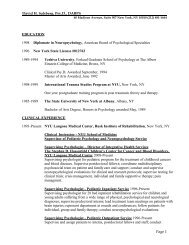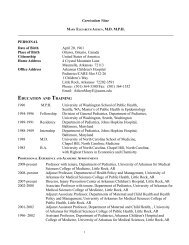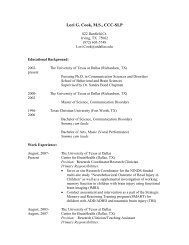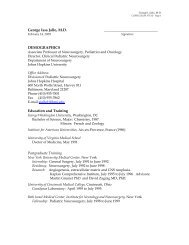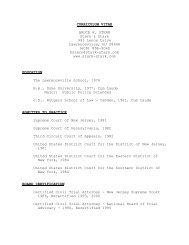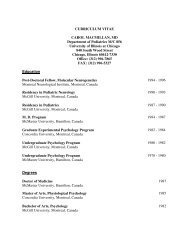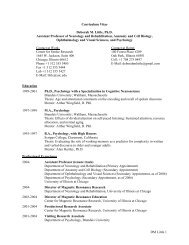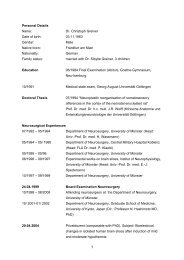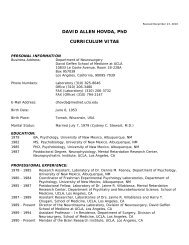BIOGRAPHICAL SKETCH NAME POSITION TITLE Ann E. Glang Research Scientist EDUCATION/TRAINING (Begin with baccalaureate or other initial professional education, such as nursing, and include postdoctoral training.) INSTITUTION AND LOCATION DEGREE YEAR(S) FIELD OF STUDY University of California, Berkeley, CA B.S. 1977 Social Welfare & French University of Oregon, Eugene, OR M.S. 1983 Special Education University of Oregon, Eugene, OR Ph.D. 1987 Special Education Positions and Employment 1987-90 Research Associate, University of Oregon, Eugene, OR 1987-91 Research Associate, Oregon Research Institute, Eugene, OR 1991-93 Adjunct Research Scientist, Oregon Research Institute, Eugene, OR 1993-06 Associate Research Professor, Teaching Research, Western Oregon University, Eugene, OR 2006- Senior Fellow and Research Professor, Teaching Research Institute, Western Oregon University, Eugene, OR 1996- Research Scientist, Oregon Center for Applied Science, Eugene, OR Peer-Reviewed Publications (in Chronological Order). Glang, A., Gersten, R., & Singer, G. (1990). Computer-assisted video instruction in training paraprofessionals to teach brain-damaged clients. Journal of Special Education Technology, 10(3), 137-146. Glang, A., Singer, G., Cooley, E., & Tish, N. (1991). Direct instruction: Applications with students with brain injury. Association for Direct Instruction News, 11(1), 23-28. Glang, A., Singer, G., Cooley, E., & Tish, N. (1992). Tailoring direct instruction techniques for use with elementary students with brain injury. Journal of Head Trauma Rehabilitation, 7(4), 93-108. Zoref, L., Glang, A., & Hall, T. (1993). Developing a volunteer reading program in your school: Strategies, successes, and challenges. <strong>The</strong> Oregon Conference Monograph, 5, 15-21. Glang, A., Gersten, R., & Morvant, M. (1994). Examining the consultation process: A case study. Learning Disabilities Research & Practice, 9(4), 225-233. Singer, G., Glang, A., Nixon, C., Cooley, E., Kerns, K., Williams, D., et al. (1994). A comparison of two psycholsocial interventions for parents of children with acquired brain injury: an exploratory study. Journal of Head Trauma Rehabilitation, 9(4), 38-49. Glang, A., Todis, B., Sohlberg, M. M., & Reed, P. (1996). Helping parents negotiate the school system. In G. H. S. Singer, A. Glang, & J. Williams (Eds.), Families and children with acquired brain injury: Challenge and adaptation. Baltimore, MD: Paul H. Brookes. Singer, G. H. S., Glang, A., & Williams, J. (Eds.). (1996). Families and children with acquired brain injury: Challenge and adaptation. Baltimore, MD: Paul H. Brookes. Sowers, J. A., Glang, A., Voss, J., & Cooley, E. A. (1996). Enhancing friendships and leisure involvement of students with traumatic brain injuries and other disabilities. In L.E. Powers, G.H.S. Singer, & J. Sowers (Eds.), Building self-competence among children with disabilities. Baltimore, MD: Paul H. Brookes. Zoref, L., Glang, A., & Hall, T. (1996). Using a volunteer reading program: What constitutes success? <strong>The</strong> Oregon Conference Monograph, 8, 67-77. Cooley, E., Glang, A., & Voss, J. (1997). Making connections: Helping children with acquired brain injury build friendships. In A. Glang, G. H. S. Singer, & B. Todis (Eds.), Children with acquired brain injury: <strong>The</strong> school’s response. Baltimore, MD: Paul H. Brookes. Todis, B., Glang, A., & Fabry, M. (1997). Family, school, child: A qualitative study of the school experiences for students with ABI. In A. Glang, G. H. S. Singer, & B. Todis (Eds.), Children with acquired brain injury: <strong>The</strong> school’s response. Baltimore, MD: Paul H. Brookes. Glang, A., Singer, G. H. S., & Todis, B. (Eds.). (1997). Children with acquired brain injury: <strong>The</strong> school’s response. Baltimore, MD: Paul H. Brookes. Glang, A., & Todis, B. (1997). Providing ongoing support to educators through team-based consultation. In A. Glang, G. H. S. Singer, & B. Todis (Eds.), Children with acquired brain injury: <strong>The</strong> school’s response. Baltimore, MD: Paul H. Brookes. Glang, A., Todis, B., Cooley, E., Wells, J., & Voss, J. (1997). Building social networks for children and adolescents with ABI: A school-based intervention. Journal Head Trauma Rehabilitation, 12(2), 32-47. Sohlberg, M., Glang, A., & Todis, B. (1998). Improvement during baseline: Three case studies encouraging collaborative research when evaluating caregiver training. <strong>Brain</strong> Injury, 12(4), 333-346. 1
Sohlberg, M., Mateer, C., Penkman, L., Glang, A., & Todis B. (1998). Awareness intervention: Who needs it? Journal of Head Trauma Rehabilitation, 13(5), 62-78. Sohlberg, M., Todis, B., & Glang, A. (1998). SCEMA: A team-based approach to serving secondary students with executive dysfunction following brain injury. Aphasiology, 12(12), 1047-1092. Glang, A., Robinson, L., & Todis, B. (1999). Collaboration between parents and educators: Partners or adversaries? <strong>Brain</strong> Injury Source, 3(3), 10-13. Todis, B., & Glang, A. (1999). School experiences of students with acquired brain injury: What happens after transition? American Speech-Language-Hearing Association Division 2 (Neurophysiology and Neurogenic Speech and Language Disorders) newsletter, 9(5), 3-8. Sohlberg, M., McLaughlin, K., Todis, B., Larsen, J., & Glang, A. (2001). What does it take to collaborate with families affected by brain injury? A preliminary model. Journal of Head Trauma Rehabilitation, 16(5), 498-509. Ylvisaker, M., Todis, B., Glang, A., Urbanczyk, B., Franklin, C., DePompei, R., et al. (2001). Educating students with TBI: <strong>The</strong>mes and recommendations. Journal of Head Trauma Rehabilitation, 16(1), 76-3. Glang, A., Tyler, J., Pearson, S., Todis, B., & Morvant, M. (2004). Improving educational services for students with TBI through statewide resource teams. NeuroRehabilitation, 19(3), 219-231. Ehlhardt, L., Sohlberg, M.M., Glang, A., Albin, R. (2005). TEACH-M: A pilot study evaluating an instructional sequence for persons with impaired memory and executive functions. <strong>Brain</strong> Injury, 19(8), 569-583. Glang, A., Noell, J., Ary, D., & Swartz, L. (2005). Using interactive multimedia to teach pedestrian safety: An exploratory study. American Journal of Health Behavior, 29(5), 435-442. Ylvisaker, M., Adelson, P.D., Braga, L.W., Burnett, S.M., Glang, A., et. al. (2005). Rehabilitation and Ongoing Support After Pediatric TBI: 20 Years of Progress. Journal of Head Trauma Rehabilitation, 20(1), 95-109. Glang, A., Dise-Lewis, J., Tyler, J., & Denslow, P. (2006). Identification and Appropriate Service Delivery for Children who have TBI; Abstracts from the 2 nd Federal Interagency Conference on Traumatic <strong>Brain</strong> Injury. Journal of Head Trauma Rehabilitation, 21, 5, 408-436 Todis, B., Glang A., Bullis, M., & Andrews, J. (2006). Longitudinal Investigation of the Post-School transition Experiences of Adolescents with TBI. Abstracts from the 2 nd Federal Interagency Conference on Traumatic <strong>Brain</strong> Injury. Journal of Head Trauma Rehabilitation, 21, 5, 408-436 Glang, A. & Lash, M. (2006). A holistic approach for improving educational outcomes of students with TBI: Promising practices and new directions for research. <strong>Brain</strong> Injury Professional, 3(4), 16-18 Todis, B., Glang A., Bullis, M., & Andrews, J. (2006). Longitudinal investigation of the post-school transition experiences of adolescents with TBI. Abstracts from the 2 nd Federal Interagency Conference on Traumatic <strong>Brain</strong> Injury. Journal of Head Trauma Rehabilitation, 21(5), 421-422. Glang, A., McLaughlin, K., & Schroeder, S. (2007). Using interactive multimedia to teach parent advocacy skills: An exploratory study. Journal of Head Trauma Rehabilitation, 22(3), 198-205. Todis, B., & Glang, A. (2008). Redefining success: Results of a qualitative study of post-secondary transition outcomes for youth with traumatic brain injury. Journal of Head Trauma Rehabilitation, 23(4), 252-263. Glang, A., Ylvisaker, M., Stein, M., Ehlhardt, L., Todis, B., & Tyler, J. (2008). Validated Instructional Practices: Application to Students with TBI. Journal of Head Trauma Rehabilitation. Glang, A., Todis, B., Thomas, C., Hood, D., Bedell, G., & Cockrell, J. (2008). Return to school following childhood TBI: Who gets services? NeuroRehabilitation, 23(6), 477-486. McLaughlin, K. & Glang, A. (in press). <strong>The</strong> effectiveness of a bicycly safety program for improving safetyrelated knowledge and behavior in young elementary students. Journal of Pediatric Psychology. Todis, B. Glang, A., Bullis, M., & Andrews, J. (submitted). Longitudinal Investigation of the Post-High School Transition Experiences of Adolescents with Traumatic <strong>Brain</strong> Injury. Journal Head Trauma Rehabilitation. Video and Curriculum Materials Noell, J., & Glang, A. (Producers/Authors). (1987). Basic skills in teaching [videotapes]. Eugene, OR: Association for Direct Instruction. Glang, A., Sohlberg, M. M., & Todis, B. (1999). Compensatory systems for students with brain injuries. Wake Forest, NC: L & A Publishing/Training. Sohlberg, M. M., Todis, B., & Glang, A. (1999). Changes in self awareness among students with brain injuries. Wake Forest, NC: L & A Publishing/Training. Sohlberg, M. M., Todis, B., Glang, A., & Lash, M. (1999). <strong>Brain</strong> injury: Causes and consequences for students. Wake Forest, NC: L & A Publishing/Training. Todis, B., Sohlberg, M. M., & Glang, A. (1999). Making the IEP process work for students with brain injury. Wake Forest, NC: L & A Publishing/Training. 2
- Page 1 and 2:
The Honorable Kathleen Sebelius Sec
- Page 3 and 4:
promote the integration and full in
- Page 5 and 6:
The National Pediatric Acquired Bra
- Page 7:
Phase Three consisted of having the
- Page 10 and 11:
the fact that their brains are stil
- Page 12 and 13:
methods developed by the SJBP to sh
- Page 14 and 15:
Two-Year Milestones Quarter 1: •
- Page 16 and 17:
Figure 2: CDC figures for death and
- Page 18 and 19:
PA/TBI and their families, delivere
- Page 20 and 21:
appropriately in the care of the ch
- Page 22 and 23:
CHAPTER 2: The TBI Model System and
- Page 24 and 25:
2. States need to “buy” into id
- Page 26 and 27:
implications of shaking a baby; and
- Page 28 and 29:
service was developed for children
- Page 30 and 31:
a. There is a lack of evidence for
- Page 32 and 33:
8. In addition, ongoing education a
- Page 34 and 35:
While there are often significant i
- Page 36 and 37:
are largely unknown. In particular,
- Page 38 and 39:
Family Perspective: Without early i
- Page 40 and 41:
4. Improve the specific identificat
- Page 42 and 43:
unemployment, public-assisted housi
- Page 44 and 45:
REFERRAL FROM ACUTE CARE, REHABILIT
- Page 46 and 47:
understanding determinants of long-
- Page 48 and 49:
Research - Increase capacity of loc
- Page 50 and 51:
Alternatively, indirect effects on
- Page 52 and 53:
Specific questions regarding tracki
- Page 54 and 55:
CHAPTER 7: Categories of Care: Tran
- Page 56 and 57:
care of syndromes associated with a
- Page 58 and 59:
Social Opportunities The services a
- Page 60 and 61:
Finally, a third area of problem af
- Page 62 and 63:
CHAPTER 8: Category of Care: Rural/
- Page 64 and 65:
• Lack of public transportation
- Page 66 and 67:
• Provide consequences for wastin
- Page 68 and 69:
Rural / Tele-health issues during A
- Page 70 and 71:
educated and thus are less aware of
- Page 72 and 73:
Chapter 9: Category of Care: The Vi
- Page 74 and 75:
"To improve the quality of our heal
- Page 76 and 77:
Registry technology has been used a
- Page 78 and 79:
CHAPTER 10: Organizational Structur
- Page 80 and 81:
Northeast Region: New York Mid-Atla
- Page 82 and 83:
State IT Manager: primary responsib
- Page 84 and 85:
translational data for their Catego
- Page 86 and 87:
CHAPTER 11: Financing the PABI Plan
- Page 88 and 89:
projects, a smaller state will have
- Page 90 and 91:
Summary of PABI Grant Proposal cont
- Page 92 and 93:
Sarah Jane Brain Family State Lead
- Page 94 and 95:
The University of Alabama at Birmin
- Page 96 and 97:
h Principal Investigator/Program Di
- Page 98 and 99:
Sarah Jane Brain Family State Lead
- Page 100 and 101:
The Children's Hospital at Providen
- Page 102 and 103:
Sarah Jane Brain Family State Lead
- Page 104 and 105:
Barrow Neurological Institute / St.
- Page 106 and 107:
Employment Education Postgraduate T
- Page 108 and 109:
Certifications Neuroscience Grand R
- Page 110 and 111:
Sarah Jane Brain Family State Lead
- Page 112 and 113:
UAMS/Arkansas Children's Hospital R
- Page 114 and 115:
Program Director/Principal Investig
- Page 116 and 117:
C. Research Support Ongoing Researc
- Page 118 and 119:
Sarah Jane Brain Family State Lead
- Page 120 and 121:
Mattel Children's Hospital UCLA Pro
- Page 122 and 123:
BIOGRAPHICAL SKETCH Provide the fol
- Page 124 and 125:
17. Madikians A and Giza CC. A Clin
- Page 126 and 127:
Sarah Jane Brain Family State Lead
- Page 128 and 129:
The Children's Hospital Profile con
- Page 130 and 131:
CURRICULUM VITAE JEANNE E. DISE, Ph
- Page 132 and 133:
Curriculum Vitae Jeanne E. Dise Pag
- Page 134 and 135:
Curriculum Vitae Jeanne E. Dise Pag
- Page 136 and 137:
Curriculum Vitae Jeanne E. Dise Pag
- Page 138 and 139:
Curriculum Vitae Jeanne E. Dise Pag
- Page 140 and 141:
Curriculum Vitae Jeanne E. Dise Pag
- Page 142 and 143:
Curriculum Vitae Jeanne E. Dise Pag
- Page 144 and 145:
Curriculum Vitae Jeanne E. Dise Pag
- Page 146 and 147:
Curriculum Vitae Jeanne E. Dise Pag
- Page 148 and 149:
Curriculum Vitae Jeanne E. Dise Pag
- Page 150 and 151:
Curriculum Vitae Jeanne E. Dise Pag
- Page 152 and 153:
Yale‐New Haven Children's Hospita
- Page 154 and 155:
Yale‐New Haven Children's Hospita
- Page 156 and 157:
2001 - Associate Professor, Sect of
- Page 158 and 159:
Major goal: to provide education in
- Page 160 and 161:
Sarah Jane Brain Family State Lead
- Page 162 and 163:
Nemours / Alfred I. duPont Hospital
- Page 164 and 165:
First Name: Michael MI: A Last Name
- Page 166 and 167:
Sarah Jane Brain Family State Lead
- Page 168 and 169:
Children's National Medical Center
- Page 170 and 171:
Program Director/Principal Investig
- Page 172 and 173:
Program Director/Principal Investig
- Page 174 and 175:
Sarah Jane Brain Family State Lead
- Page 176 and 177:
University of Miami Miller School o
- Page 178 and 179:
FF Principal Investigator/Program D
- Page 180 and 181:
FF Principal Investigator/Program D
- Page 182 and 183:
FF Principal Investigator/Program D
- Page 184 and 185:
Huang TT, He D, Kleiner G, Kuluz J.
- Page 186 and 187:
Children's Healthcare of Atlanta Pr
- Page 188 and 189:
Children's Healthcare of Atlanta Pr
- Page 190 and 191:
Principal Investigator: Haarbauer-K
- Page 192 and 193:
Sarah Jane Brain Family State Lead
- Page 194 and 195:
Center on Disability Studies at The
- Page 196 and 197:
Jean L. Johnson, DrPH April 19, 200
- Page 198 and 199:
Jeffrey K. Okamoto M.D. Curriculum
- Page 200 and 201:
Sarah Jane Brain Family State Lead
- Page 202 and 203:
Idaho State University / Institute
- Page 204 and 205:
NAME RUSSELL C. SPEARMAN BIOGRAPHIC
- Page 206 and 207:
Spearman, Russell, C Spearman, R.C.
- Page 208 and 209:
RESEARCH FUNDING Current Support: I
- Page 210 and 211:
University of Illinois Chicago Prof
- Page 212 and 213:
University of Illinois Chicago Prof
- Page 214 and 215:
1997 Margaret Faust Thesis Award, S
- Page 216 and 217:
Sarah Jane Brain Family State Lead
- Page 218 and 219:
James Whitcomb Riley Hospital for C
- Page 220 and 221:
PROGRAM DIRECTOR: Jodi L. Smith, Ph
- Page 222 and 223:
American Association of Anatomists
- Page 224 and 225:
IU Faculty Steering Committee ‐ 7
- Page 226 and 227:
Sarah Jane Brain Family State Lead
- Page 228 and 229:
University of Iowa Children's Hospi
- Page 230 and 231:
NAME Lindgren, Scott D. eRA COMMONS
- Page 232 and 233:
Arroyos-Jurado, E., Paulsen, J.S.,
- Page 234 and 235:
Center for Child Health and Develop
- Page 236 and 237:
Center for Child Health and Develop
- Page 238 and 239:
Tyler 2 Glang, A., Dise-Lewis, J.,
- Page 240 and 241:
Tyler 4 DePompei, R., Glang, A., &
- Page 242 and 243:
University of Kentucky Hospital Pro
- Page 244 and 245:
University of Kentucky Hospital Pro
- Page 246 and 247:
Joseph A. Iocono, M.D. Curriculum V
- Page 248 and 249:
Joseph A. Iocono, M.D. Curriculum V
- Page 250 and 251:
Joseph A. Iocono, M.D. Curriculum V
- Page 252 and 253:
Joseph A. Iocono, M.D. Curriculum V
- Page 254 and 255:
Joseph A. Iocono, M.D. Curriculum V
- Page 256 and 257:
Joseph A. Iocono, M.D Curriculum Vi
- Page 258 and 259:
Joseph A. Iocono, M.D. Curriculum V
- Page 260 and 261:
Joseph A. Iocono, M.D Curriculum Vi
- Page 262 and 263:
Joseph A. Iocono, M.D Curriculum Vi
- Page 264 and 265:
Joseph A. Iocono, M.D Curriculum Vi
- Page 266 and 267:
Joseph A. Iocono, M.D Curriculum Vi
- Page 268 and 269:
Sarah Jane Brain Family State Lead
- Page 270 and 271:
Louisiana Health Care Quality Forum
- Page 272 and 273:
Shannon Robshaw, MSW is the Executi
- Page 274 and 275:
Maine Institute of Human Genetics a
- Page 276 and 277:
Maine Institute of Human Genetics a
- Page 278 and 279:
Principal Investigator/Program Dire
- Page 280 and 281:
Principal Investigator/Program Dire
- Page 282 and 283:
Kennedy Krieger Institute Profile c
- Page 284 and 285:
Kennedy Krieger Institute Profile c
- Page 286 and 287:
Principal Investigator/Program Dire
- Page 288 and 289:
Principal Investigator/Program Dire
- Page 290 and 291:
Program Director/Principal Investig
- Page 292 and 293:
Sarah Jane Brain Family State Lead
- Page 294 and 295:
Children's Hospital of Boston and H
- Page 296 and 297:
Date Updated: November 5, 2008 CURR
- Page 298 and 299:
2001- Member, Advisory Committee Ha
- Page 300 and 301:
underway to best direct prevention
- Page 302 and 303:
2. Mooney DP, Lewis JE, Connors RH,
- Page 304 and 305:
40. Waltzman M, Baskin M, Wypij D,
- Page 306 and 307:
19. Downard C and Mooney DP. Pediat
- Page 308 and 309:
47. Kangas KK, Lee LK, Forbes P, Os
- Page 310 and 311:
29. Kansas Trauma Conference, Wichi
- Page 312 and 313:
Date Prepared: January 5, 2009 Name
- Page 314 and 315:
Regional 2006- Vice President of Ma
- Page 316 and 317:
Honors and Prizes Year Name of Hono
- Page 318 and 319:
2000 Pediatric Spine Injuries Singl
- Page 320 and 321:
2006 Infant Skull Deformities Pedia
- Page 322 and 323:
2002 Management of Sports-related C
- Page 324 and 325:
Clinical Innovations I have been ab
- Page 326 and 327:
10. Dunn IF, Proctor MR, Day AL. Lu
- Page 328 and 329:
Trauma Surgery, Neurology, Neuropsy
- Page 330 and 331:
Michigan Public Health Institute an
- Page 332 and 333:
Michigan Public Health Institute an
- Page 334 and 335:
Vonderheid, S.C., Pohl, J. M., Tann
- Page 336 and 337:
Mayo Clinic Profile continued Title
- Page 338 and 339:
Mayo Clinic Profile continued Title
- Page 340 and 341:
LICENSURE Minnesota HONORS/AWARDS S
- Page 342 and 343:
Spina Bifida in Adulthood Physical
- Page 344 and 345:
Sherilyn W. Driscoll, MD Page 6 of
- Page 346 and 347:
-Implementation of new pediatric wh
- Page 348 and 349:
BIBLIOGRAPHY Peer-reviewed Articles
- Page 350 and 351:
Program Director/Principal Investig
- Page 352 and 353:
Sarah Jane Brain Family State Lead
- Page 354 and 355:
Children's Rehabilitation Services
- Page 356 and 357:
Curriculum Vitae Shannon Janine Smi
- Page 358 and 359:
Shannon Janine Smith, MD Page 2 Hon
- Page 360 and 361:
Center, Pediatric Grand Rounds Shan
- Page 362 and 363:
Saint Louis Children's Hospital Pro
- Page 364 and 365:
Saint Louis Children's Hospital Pro
- Page 366 and 367:
Principal Investigator/Program Dire
- Page 368 and 369:
Completed Research Support Principa
- Page 370 and 371:
Montana State University Billings /
- Page 372 and 373:
Montana State University Billings /
- Page 374 and 375:
• Region IV Paraeducator Summer I
- Page 376 and 377:
Madonna Rehabilitation Hospital Pro
- Page 378 and 379:
Madonna Rehabilitation Hospital Pro
- Page 380 and 381:
Staff Occupational Therapist: 1997-
- Page 382 and 383:
Sunrise Children's Hospital Profile
- Page 384 and 385:
Sunrise Children's Hospital Profile
- Page 386 and 387:
Sarah Jane Brain Family State Lead
- Page 388 and 389:
Dartmouth Medical School Profile co
- Page 390 and 391:
BIOGRAPHICAL SKETCH NAME POSITION T
- Page 392 and 393:
Sarah Jane Brain Family State Lead
- Page 394 and 395:
Brain Injury Association of New Jer
- Page 396 and 397:
Biographical Sketch Barbara Geiger-
- Page 398 and 399: Sarah Jane Brain Family State Lead
- Page 400 and 401: University of New Mexico School of
- Page 402 and 403: Sarah Jane Brain Family State Lead
- Page 404 and 405: Mount Sinai Medical Center Profile
- Page 410 and 411: Sarah Jane Brain Family State Lead
- Page 412 and 413: The Clinical Center for the Study o
- Page 414 and 415: NAME Stephen R. Hooper eRA COMMONS
- Page 416 and 417: Hooper, S.R., Hatton, D., Schaaf, J
- Page 418 and 419: Sarah Jane Brain Family State Lead
- Page 420 and 421: Still pending Profile continued Tit
- Page 422 and 423: Sarah Jane Brain Family State Lead
- Page 424 and 425: Cincinnati Children's Hospital Medi
- Page 426 and 427: Principal Investigator/Program Dire
- Page 428 and 429: Principal Investigator/Program Dire
- Page 430 and 431: Sarah Jane Brain Family State Lead
- Page 432 and 433: Oklahoma State University / Center
- Page 434 and 435: CURRICULUM VITAE NAME Stanley E. Gr
- Page 436 and 437: Courtesy Staff, 1990-1998 Leave of
- Page 438 and 439: OSU-CHS International Medicine Club
- Page 440 and 441: ViroPharma Protocol 637-303: Princi
- Page 442 and 443: Media presentations: Medical Minute
- Page 444 and 445: Sarah Jane Brain Family State Lead
- Page 446 and 447: Teaching Research Institute and Wes
- Page 450 and 451: Voss, J., Stevens, T., Glang, A., &
- Page 452 and 453: Sarah Jane Brain Family State Lead
- Page 454 and 455: Children's Hospital of Pittsburgh o
- Page 456 and 457: BIOGRAPHICAL SKETCH Provide the fol
- Page 458 and 459: C. Research Support. List selected
- Page 460 and 461: Puerto Rico Medical Center / Univer
- Page 462 and 463: Puerto Rico Medical Center / Univer
- Page 464 and 465: LICENCE TO PRACTICE MEDICINE: (plac
- Page 466 and 467: REFERENCES Dr. Nathan Rifkinson, UP
- Page 468 and 469: Hasbro Children's Hospital Child Pr
- Page 470 and 471: Hasbro Children's Hospital Child Pr
- Page 472 and 473: 1990-1996 Director of Medical Progr
- Page 474 and 475: infant death and suspected physical
- Page 476 and 477: Medical University of South Carolin
- Page 478 and 479: Medical University of South Carolin
- Page 480 and 481: Principal Investigator/Program Dire
- Page 482 and 483: Role: PI Principal Investigator/Pro
- Page 484 and 485: Center for Disabilities / Sanford S
- Page 486 and 487: Center for Disabilities / Sanford S
- Page 488 and 489: • February 2004 - May 2005: Indep
- Page 490 and 491: • September 2008: Presentation at
- Page 492 and 493: • Coordinator for LEND (The South
- Page 494 and 495: University of Tennessee Profile con
- Page 496 and 497: University of Tennessee Profile con
- Page 498 and 499:
4. Johnson, R. K., Hough, M. S., Ki
- Page 500 and 501:
Center for BrainHealth / The Univer
- Page 502 and 503:
Center for BrainHealth / The Univer
- Page 504 and 505:
McCauley, S.R., McDaniel, M.A., Ped
- Page 506 and 507:
Levin, H. S., Mendelsohn, D. B., Li
- Page 508 and 509:
University of Utah Profile continue
- Page 510 and 511:
University of Utah Profile continue
- Page 512 and 513:
5. Statler KD, Jenkins LW, Dixon CE
- Page 514 and 515:
F. Invited Presentations Internatio
- Page 516 and 517:
The Vermont Center for Children, Yo
- Page 518 and 519:
The Vermont Center for Children, Yo
- Page 520 and 521:
2006-Present Chairman of the Child
- Page 522 and 523:
Abdellaoui A, Bartels M, Hudziak JJ
- Page 524 and 525:
UVA Children's Hospital and Kluge's
- Page 526 and 527:
UVA Children's Hospital and Kluge's
- Page 528 and 529:
B. Selected peer-reviewed publicati
- Page 530 and 531:
University of Washington / Harborvi
- Page 532 and 533:
University of Washington / Harborvi
- Page 534 and 535:
Principal Investigator/Program Dire
- Page 536 and 537:
Principal Investigator/Program Dire
- Page 538 and 539:
Principal Investigator/Program Dire
- Page 540 and 541:
West Virginia Brain Injury Associat
- Page 542 and 543:
West Virginia Brain Injury Associat
- Page 544 and 545:
Phone: (304) 345-7757 405 Capitol S
- Page 546 and 547:
Children's Hospital of Wisconsin Pr
- Page 548 and 549:
Children's Hospital of Wisconsin Pr
- Page 550 and 551:
Principal Investigator/Program Dire
- Page 552 and 553:
Sarah Jane Brain Family State Lead
- Page 554 and 555:
Brain Injury Association of Wyoming
- Page 556 and 557:
EDUCATION Dorothy Worrell 2302 Sage
- Page 558 and 559:
of Developmental Disabilities; assi
- Page 560 and 561:
PUBLICATIONS Member of VISIONS Admi
- Page 562 and 563:
Sarah Jane Brain Family State Lead
- Page 564 and 565:
n/a Profile continued Title/Descrip
- Page 566 and 567:
References 1. Adelson, P.D. (2008).
- Page 568 and 569:
30. Centers for Disease Control and
- Page 570 and 571:
62. Haddon, W. (1973). Energy damag
- Page 572 and 573:
96. Perel, P., Yanagawa, T., Bunn,



